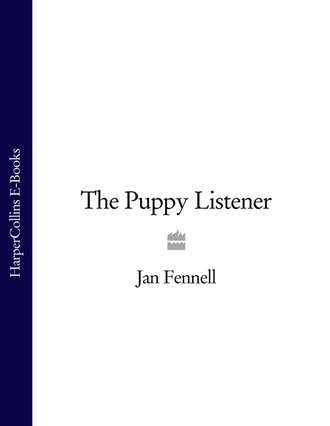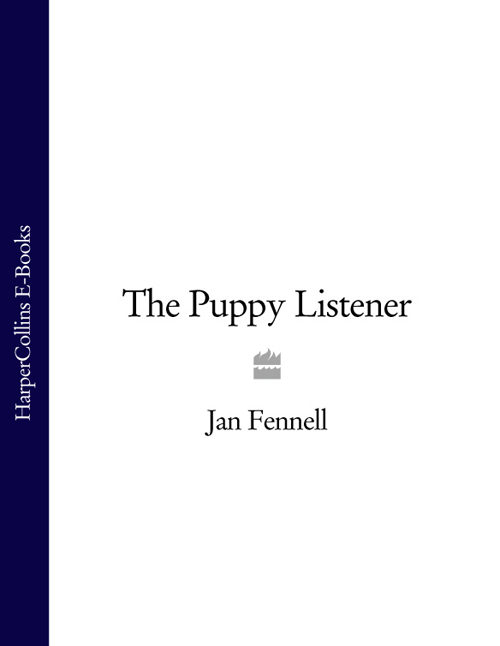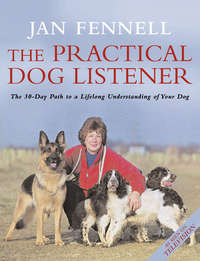
Полная версия
The Puppy Listener


THE PUPPY LISTENER
Understanding and caring for your new puppy
JAN FENNELL

I dedicate this book to the dogs I have had the joy of sharing my life with, and thank them for their patience which made it possible for me to really understand them
Contents
Cover
Title Page
Introduction
Chapter 1 - What is a Dog?
Chapter 2 - Your Puppy’s First Weeks of Life
Chapter 3 - Choosing your Dog
Chapter 4 - Making your New Puppy Feel at Home
Chapter 5 - A Healthy Diet: The Essentials
Chapter 6 - The Foundation Stones of Training
Chapter 7 - Grooming: The Key to Good Health
Chapter 8 - Behavioural Problems and Solutions
Chapter 9 - Health Checks in the Early Weeks
Chapter 10 - The Home VET: Checking your Dog’s Health
Chapter 11 - Pushing the Boundaries
Chapter 12 - Understanding your Dog’s Body Language
Chapter 13 - Monitoring the Physical Changes in your Puppy
Conclusion
Further Information
Index
Also by Jan Fennell
Copyright
About the Publisher
Introduction
For sheer joy and excitement, there is nothing quite like a new puppy. The pleasure these bouncing, bright-eyed balls of energy can bring into your life is immense, beyond words at times. I know this from personal experience.
As someone who has been surrounded by dogs since an early age, I’ve been lucky enough to have shared my life with dozens of puppies. They have come in all shapes and sizes, all sorts of breeds, and they have all been memorable canine characters. Many of them have provided me with some of my happiest memories as a dog owner.
As anyone who has ever owned a puppy knows, however, introducing a young dog into your home is never, ever easy. In fact it can be the precise opposite of that – it can be hard work. A puppy’s energy and exuberance can produce mayhem if let loose in the wrong direction, as any dog owner who has witnessed a hyper-active pup run amok in their living room will testify.
So it’s been no surprise to me that, ever since I began helping owners to understand and communicate with their canine companions more than a decade ago, puppies have always been high on the agenda. Indeed, while running my courses, offering consultations or giving talks around the world, questions about living with puppies arise more often than any other dog-related issues. Owners want to know about every aspect of puppy ownership: from choosing a new dog to introducing it to the home, from vaccinating to worming, grooming to training.
The answers to their diverse questions vary, of course, but there is always a common thread. Almost always I discover that the roots of any problems lie in the fact that owners have made mistakes at the beginning of their lives with their puppies. They have got off to the wrong start.
In their defence, I have to say that it is very easy to go wrong. The first six months are, without doubt, the most important in a young dog’s life, and they are also the most challenging for an owner. For all their innocence and pure charm, puppies are not as straightforward as they seem.
SHOW ME THE DOG OF SIX MONTHS …
Comparing the age of a dog to that of a human is not straightforward. The old rule of thumb that one dog year is equivalent to seven human years isn’t really accurate. But it is safe to say that the first six months of a puppy’s life is roughly the equivalent of between four and seven human years. In other words, it’s a significant part of their life.
Think how important these years are in forming a young child’s personality. ‘Show me the boy of seven and I will show you the man,’ the old saying goes, and it is the same with a puppy. Show me a puppy of six months old, and I will show you the dog it is going to become. This is why this period is so crucial for you, the dog owner.
Good dog ownership is always about getting off to the right start, no matter how old your new dog, but this is especially true with puppies. Your puppy needs to learn to eat, sleep and go to the toilet properly. It needs to learn how and when to play, how to interact with its human companions and – crucially – how to listen to those companions when required. Most importantly of all, it must understand its place in the human world in which it lives. And it must know how to accept you, its owner, as the leader of its domestic pack.
The lessons a puppy learns during these six months will remain with it for the rest of its life. They will dictate what kind of dog it will become in adulthood. So if you, as an owner get things right now, you will be able to look forward to a happy, contented and hopefully long relationship with your new dog. If you get them wrong, on the other hand, your problems are only just beginning.
This book is a guide to the first six months of your puppy’s life. It will tell you what is going on physically and mentally in the dog’s body and mind and it will take you step-by-step through the important stages you, as an owner, will have to deal with – in particular, from eight weeks of age when the vast majority of you will be taking charge of your new puppy.
Of course, there is nothing more exhilarating and life-affirming than spending time with the buoyant force of fun-loving nature that is a puppy. Puppyhood should be a time for both dog and owner to enjoy their lives together. Not to do so would be a crime! So there is also plenty of information about how to play and have fun with your puppy too. I hope this book helps you make sure that life is as long and happy as it possibly can be.
Jan Fennell, Lincolnshire, October 2010
Chapter 1 - What is a Dog?
To communicate with your puppy properly you need to understand what makes it tick. And to understand that, you must first understand the answer to what might seem like a simple question: what is a dog? The answer is more complicated than you might imagine. But it will explain everything you need to know about the animal that is about to become your new best friend.
Of all the animals on earth, the dog is by far man’s oldest and closest domestic partner. Our remarkable friendship dates back some 14,000 years. It was around then, so scientists believe, that wolves were first taken in by humans living in early communities. It was a good deal for both sides, as they both got something out of the new alliance. Wolves provided humans with their superior senses, which gave them an early warning system as well as powerful hunting and tracking abilities. Man provided their new partners with easy access to that precious commodity, food.
As the wolf learned to live in close proximity to humans, it evolved into a different kind of animal. It no longer had to rely on hunting and killing other animals for food. It amended its behaviour to gain acceptance in human society. As its diet changed from raw meat to human leftovers, its skull and teeth became smaller relative to the rest of its body. Its brain shrank too. Slowly the wolf became the first species to be domesticated by mankind. The wild animal became a tame one; Canis lupus became Canis familiaris.
In the thousands of years that have passed since then, selective breeding on the part of man has turned the dog into the most varied species on the planet. If dogs had been left to survive in the natural world, they would have evolved very little. Instead, over the centuries man has crossbred dogs with different traits and talents, creating what are in effect hybrids. And these dogs have reflected the different physical demands, as well as the aesthetic tastes and fashions, of humans through the ages and around the world.
THE MAIN GROUPS OF DOG
Dogs have been bred to specialise in a variety of roles, from running down prey to retrieving shot birds, from guarding houses to acting as guides for blind people.
Their DNA, and even their basic skeletal structure, remains identical to that of the wolf. But the several hundred different breeds of dog that now exist come in every conceivable shape, size and design. And while some dogs, such as the Siberian Husky or Alaskan Malamute, closely resemble the prototype of the species, other breeds bear little resemblance to their forefather. You certainly wouldn’t automatically assume that the Miniature Poodle and the Old English Sheepdog have common ancestors.
Broadly speaking, there are seven main groups of dogs. Descriptions of each follow, along with a list of the main breeds within each group.
GUNDOGS OR SPORTING DOGS
A large number of dog breeds evolved according to the jobs humans needed them to do. When the invention of the gun provided a new way of hunting, new varieties of dogs were bred to perform very specific tasks. Dogs with sensitive noses were bred to locate or ‘point’ to the hunters’ targets. Other breeds were developed to flush out or ‘spring’ the prey, usually birds. Yet more dogs were bred to retrieve the prey once it had been shot. Specific traits were bred into each of these dogs. Retrieving dogs, for instance, were bred to have ‘soft mouths’, which ensured there was no damage to the birds they recovered.
Common breeds within this category include the Golden Retriever; German Shorthaired Pointer; the Irish, Gordon and English Setters; the Cocker, American Cocker, English Springer and Field Spaniels; and the Labrador and Chesapeake Bay Retrievers. The group also includes the Weimaraner and the Hungarian Vizsla.
WORKING DOGS
Over the centuries, humans have bred dogs to do a huge range of different jobs. Breeds have been produced specifically to rescue people from drowning, guide them across snow-covered mountains, alert them to intruders, sniff out explosives and guide the blind. This diverse collection of working dogs includes the Alaskan Malamute and the Bernese Mountain Dog, the St Bernard and the Dobermann, the Boxer and the Bullmastiff. Each of these was bred to excel at specific activities.
HOUNDS
Some of the earliest breeds developed by man were used as ‘sight’ or ‘gaze’ hounds. Such dogs are described in ancient Persian manuscripts and appear in Egyptian tomb paintings. Their special skill was to hunt down prey that humans and their horses, bows and arrows couldn’t reach in open country. Often helped by trained falcons, these dogs had the ability to creep up swiftly and silently, running down the prey so that the hunters could close in for the kill. The Saluki and the Afghan are amongst the oldest examples of this group of dog. More modern versions include the Irish Wolfhound and the Greyhound. Centuries later, Europeans developed ‘scent’ hound breeds that were able to trail quarry over long distances, eventually exhausting it. Some killed the prey, others kept it cornered while baying to attract the hunters to them. The Elkhound was a typical example of this type of dog. More modern versions include the Bloodhound and the Basset Hound.
It is a measure of the diversity of the demands humans have placed on their dogs that this group contains some of the greatest contrasts within the canine world: from the tallest of breeds, the Irish Wolfhound, to one of the shortest, the Dachshund; from the fastest, the Greyhound, to the most silent, the only non-barking breed, the Basenji.
TERRIERS
The name Terrier comes from the Latin terra, meaning earth. As the name suggests, the original terriers were bred to hunt creatures considered by humans as vermin that lived both above and below the ground, such as foxes, badgers, rats and otters. Terriers date back many centuries and are believed to have originated largely in Britain. Popular breeds include the Airedale and the Bull, the Cairn and the Fox, the Irish and the West Highland.
TOY DOGS
Dogs haven’t only been bred for working purposes, however. Throughout history, man has produced dogs that have provided him with nothing more than warmth and companionship, affection and aesthetic pleasure. Lapdogs, for instance, were – as their name suggests – bred specifically to sit on the laps of Tibetan monks. Elsewhere, aristocrats produced breeds that appealed only for the admiring looks they won in and around the royal court. Toy breeds include the Maltese and the Pomeranian, the Pekingese and the Cavalier King Charles Spaniel, the Yorkshire Terrier and the Bichon Frise.
UTILITY OR NON-SPORTING DOGS
Such is the range of breeds man has created, there are many that don’t fit conveniently into any of the main categories in terms of sport or work. Unsurprisingly, the dogs within this group have hugely contrasting appearances. They include such diverse dogs as the Japanese Akita and the Miniature Poodle, the Dalmatian and the Chow Chow, the Mexican Hairless and the Lhasa Apso.
PASTORAL OR HERDING DOGS
Among the most useful and intelligent dogs ever bred are those traditionally used for herding. They have been bred to work in different climates and with different animals, from cattle and sheep to reindeer. Because they work in the face of the elements, they have evolved tough, weatherproofed double coats to protect them from even the most severe weather conditions. The most popular breeds of this type are the German Shepherd and the Border Collie, the Old English Sheepdog and the Samoyed. In different parts of the world, breeds range from the Australian Shepherd and Cattle Dogs to the Belgian Shepherd Dog, from the Finnish Lapphund to the Norwegian Buhund, from the Polish Lowland Sheepdog to the Pyrenean Mountain Dog.
THE WOLF IN YOUR PUPPY
Given their physical differences and the very different environments into which they will be introduced, modern dogs live lives more diverse than those of any other species on earth. Some will work, whether as sheepdogs or guide dogs, sniffer dogs or police dogs, some will breed and raise families, while others will simply provide companionship and pleasure. Whatever breed they are – and whatever life they lead – two things are certain. They all share the same DNA and the same basic programming as their ancient ancestor, the wolf. And because of this each of their lives will conform to a distinct pattern.
It may not seem as though your adorable ball of fluff is a wild animal as it curls itself up in front of your fireplace but, deep within its DNA, that’s precisely what it is. You can take the dog out of the wolf pack, but you can’t take the wolf pack out of the dog. To understand what your puppy is going through during its first six months, you first need to understand what happens in the natural world.
A wolf pup spends the first part of its life, around six months, in close proximity to the den where it is raised. During these months it passes through the first distinct phases of its life.
For the first three weeks or so, the wolf pup is utterly dependent on its mother. It remains close to her at all times, suckling from her bosom in the den. During this time, the family unit remains undisturbed by the rest of the pack. Despite being the leader of the pack, even their father, the alpha male, stays away during this time.
After three weeks or so, the puppies will be able to walk and make their first, furtive movements away from their mother. At the same time their father, the alpha, and the rest of the pack begin interacting with them. A wolf pack is a well-oiled machine, a tightly knit team in which each member knows its place and its job. And from the very beginning each wolf is groomed to take its position in that chain of command.
During the pups’ first weeks every adult wolf has become ‘broody’, producing a hormone called prolactin. They know the newcomers represent the pack’s future survival. They know too that more than half of the new litter will not survive into adulthood. Disease, starvation and predators claim 60 per cent of young wolves before they reach the age of two. So as the pups emerge into the den, the pack begins the job of educating their new members about the day-to-day realities of surviving lupine life.
The messages the pups receive during this phase are powerful and formative ones. They see how facial expression and body language convey important signals about status. They learn how their elders use these signals to avoid confrontations. They see that rank is determined by a combination of experience and personality, with the stronger characters rising to the top of the pack. And by watching the way the grown-up wolves interact, particularly with the alpha male, the pups get their first glimpses of how the very top of that hierarchy works.
But the most immediate lessons they learn come from play. As they begin chasing, retrieving and play-fighting with their siblings, they develop their physical abilities and begin to see where their strengths – and ultimately their place in the pack – lie. This is the very beginning of their preparation for fully-fledged membership of the pack. In time the natural herders, stalkers and attackers will emerge.
By the time it is eight weeks or so old, a wolf pup will be ready to venture a little further afield. It will begin to chase insects, birds or other creatures that gather around the pack. The play rituals it undergoes with its siblings and other members of the pack will intensify. The young wolf will develop its abilities to run and jump, wrestle and bite, skills that it will come to need when it joins the hunters. Any ideas a young wolf might have of heading off on the hunt will be quickly dispelled, however. Leaving the den at this stage would make it vulnerable to attack by predators. The senior wolves will give pups a signal, delivered in clear, unequivocal terms: ‘Stay at home; you’re not ready to join us yet.’ They will also choose one senior wolf to remain with the pups. Once again, the hierarchy of the pack – and the young wolf’s place within that structure – is driven home.
By the time it reaches its fifth and sixth months, the wolf pup is developing fast both physically and mentally. Inside the den and around its perimeter, the building blocks are continuing to be laid for its emergence – eighteen months or so down the line – as a mature, adult wolf.
It may seem hard to equate the life of a wild animal to that of the lovable creature that shares your life but it is crucial that you do. The stages of their development are very similar, as are their capabilities at each age. Certain wolf instincts are hard-wired into the brains of domestic dogs, and it is only by seeing your pet as a domesticated wolf that you will be able to understand its behaviour and learn how to deal with it effectively.
In this book, I’ll explain all about looking after dogs from birth up to six months, and show the ways in which your puppy’s ancestors continue to affect it today.
Chapter 2 - Your Puppy’s First Weeks of Life
Most people will acquire a puppy some time after it is eight weeks old. For you to understand your puppy properly, it is important that you understand what goes on during those first eight weeks. How has it developed? What have been the most important moments so far? What factors do you need to bear in mind as you take over ownership of a puppy?
THE EARLY HOURS – BIRTH AND BEYOND
The first few moments of a dog’s life are traumatic. The newborn puppy emerges from the warm, safe, dark environment that is the womb into a world filled with new smells and sensations.
Fortunately its mother will be there to reassure and care for it. She will be fixated on its welfare for the crucial first two to three weeks to come.
Because it can’t hear or see, the newborn puppy has very little concept of what is happening during the first ten days. It does not yet have any concept of its self or its siblings. It can do little more than sleep, drag itself on to its mother’s teat when it feels the need for food and whine when it is feeling cold, hungry or in pain.
The mother’s role is all-encompassing during this phase. As well as feeding her pups, she also stimulates them to defecate and urinate then eats their faeces and licks up the urine so as to keep the den clean and free from germs. Not only is she the sole source of food but she is also the only means of keeping warm. A newborn pup can’t generate or retain heat so contact with its mother is vital for its survival. This is why the mother hardly strays more than a couple of feet from her newborns during this phase of their young lives.
Yet even at this point, the first signs of personality and status are emerging within the litter. The mother’s teats are arranged in pairs along the length of her belly, with the best supply of milk available from the middle teats. Already the litter will have begun jostling for access to these prime feeding stations. Some will have forced themselves on to the best teats, while others will have been forced to feed off the less available outer and forward teats. Some may even have been pushed away from the teats altogether and it’s possible they might die.
TEN DAYS TO THREE WEEKS OLD
The first major turning point in a dog’s development comes at about ten days. Around this time the eyes begin to open, ungluing themselves from the inside to the out over a period of three to four days. They then learn to focus. At the same time their hearing is beginning to come into operation as well.
With these senses functioning, puppies become aware of the environment around them. Although they spend a huge proportion of their time sleeping they are also noticing – to their surprise – that they are not alone: they have siblings. They learn to recognise their mum by look and by sound as well as by smell. They start sniffing the perimeter of the whelping box as if signalling their readiness to explore the wider world. They will begin getting up on their legs, trying to find their balance and co-ordination and make their first tentative steps. There is a lot of investigation of what they are capable of – and what others are capable of. The puppies will begin climbing over each other, trying to gain height advantage over their siblings. There is a lot of sparring and blatting at this point. There are practical lessons to learn too. At this time, for instance, they learn to lap water from a bowl.
All this activity comes in short bursts, however. Within a maximum of five minutes they will be asleep again.
THREE TO EIGHT WEEKS
By the three-week point in puppies’ development, with their eyes, ears and nose all now functioning, they are reacting more to sight, smell and sound. They start to bark and make more sounds. They start to wag their tails. They start scratching themselves and shaking their heads. And they start play fighting with their siblings. This is an extension of the interaction that’s been going on already, as they bite each other and try to climb up to give themselves a height advantage. They are developing answers to some key questions. Where do I fit into this pack? What am I capable of doing physically? But they are also asking the question, what – and who – is outside the immediate confines of the whelping box. They are ready to claim a little independence for themselves.
In the wild, it is now that the pack really comes into its own. While the pups were being suckled by their mother, the alpha female, the excitement has been building in the rest of the pack. The other wolves – both male and female – have been producing prolactin, which makes them ‘broody’ too. Now, as the mother invites the father and the rest of the extended family to join her, they start to perform their role as surrogate parents.
Wolves from all parts of the pack hierarchy will do their bit to educate, assimilate and act as mentors for the new pup. This is how the pup gains the important information it will need in order to be a properly functioning – and happy – adult member of the pack. They will set boundaries – gently dragging the pups back when they wander too far from the den. In short, they are teaching them the rules and the language of the pack.







